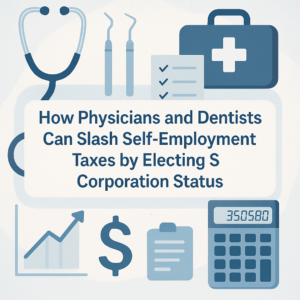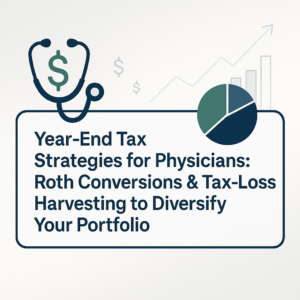How Demographics Could Shape Your Investment Strategy: A Guide for Healthcare Professionals
As a busy physician, dentist, or allied healthcare professional, you juggle patient care, continuing education, and personal life. Yet, understanding broad economic forces—like generational shifts in age and workforce size—can give you an edge in planning for long-term financial goals. In this article, we’ll explore how demographics influence market returns, why they matter for doctors and dentists, and practical steps you can take today to build a resilient investment strategy.
1. Why Healthcare Professionals Should Care About Demographics
When you think of financial planning, you may focus on your salary, student loans, and short-term cash flow. But economies and stock markets respond to more than just interest rates and corporate earnings—they’re also shaped by population trends.
- Working-Age Population: The number of people aged 15–64 often correlates with overall economic growth.
- Aging Populations: As Baby Boomers retire, they shift from saving to spending down assets, which can influence equity demand.
- Birth Rates & Immigration: Lower birth rates or restrictive immigration policies can slow workforce growth—and potentially GDP growth.
By understanding these dynamics, you gain insight into long-term market trends, helping you refine your asset allocation for physicians and choose the right mix of equities, bonds, and alternative investments.
2. The Research: Demographics and Stock Market Returns
Numerous studies highlight demographic effects on market performance:
- From 1900–2013, developing economies saw a positive link between population growth and equity returns.
- A Federal Reserve analysis found demographic factors significantly contributed to slower growth in OECD countries after 2000.
- Rob Arnott and Denis Chaves (2012) discovered that a 1% rise in the 50–54 age cohort associates with a 1% uptick in stock returns, while a 1% growth in those aged 70+ correlates with a 1.5% decline.
However, pure demographic forecasts can miss the mark. Arnott and Chaves’ prediction for 2011–2020 returns based solely on age distribution underperformed because technological innovation, policy shifts, and global capital flows also drive markets.
3. What This Means for Your Retirement Planning for Dentists and Colleagues
As you progress in your healthcare career, retirement planning becomes critical. Here’s how demographic trends intersect with your path:
3.1 Shifts in Demand for Services
As populations age, demand for healthcare and dental services grows. This can benefit healthcare-sector stocks and exchange-traded funds (ETFs). Yet, an older population also means higher healthcare costs and potential changes in reimbursement policies.
3.2 Interest Rate & Policy Implications
Central banks factor in demographics when setting monetary policy. Slower workforce growth can lead to lower inflationary pressures—and historically, lower rates. For financial strategies for doctors, this could mean a prolonged low-rate environment, affecting bond yields and borrowing costs.
3.3 Balancing Growth & Income
Even if demographic headwinds dampen equity returns, owning diversified, income-producing assets—such as dividend-paying stocks, real estate investment trusts (REITs), and high-quality bonds—helps smooth portfolio volatility. This approach resonates with many physicians seeking both growth and reliable cash flow.
4. Building a Demographically Aware Portfolio
Here are practical steps to incorporate demographic insights into your investing for doctors roadmap:
- Diversify Globally: Different regions age at different rates. Emerging markets often have younger populations and stronger workforce growth—potentially higher GDP expansion and equity returns.
- Consider Sector Exposure: Healthcare, technology, and consumer staples may outperform during demographic shifts. Technology innovation can mitigate slowing growth by boosting productivity.
- Emphasize Quality & Dividends: Companies with stable cash flows and dividend track records can provide income if demographic pressures dampen overall market returns.
- Rebalance Regularly: A disciplined rebalance helps lock in gains from outperforming assets and reinvest in underweights—keeping your portfolio aligned with risk tolerance and goals.
Learn more about our tailored approach in Our Process.
5. Common Questions from Healthcare Professionals
Q1: Should I time my investments based on demographic trends?
Market timing rarely works. Instead, focus on a long-term plan that balances growth and income, adjusts for risk, and considers global diversification.
Q2: How much should I allocate to international equities?
Allocation depends on your risk tolerance and investment horizon. Younger physicians might lean toward higher equity – both domestic and international – while those closer to retirement might shift more to income assets.
Q3: What role do alternative investments play?
Alternatives, such as real estate or private credit, can offer diversification and steady income streams. They may be less correlated with traditional markets, helping to manage volatility during demographic shifts.
6. How to Get Started
Ready to build a robust portfolio that accounts for demographic dynamics? At Mainstay Capital, we specialize in financial planning for healthcare professionals. Here’s how to begin:
- Schedule a discovery call via our Contact page.
- Complete our risk-tolerance questionnaire.
- Review a customized investment plan integrating market, demographic, and personal factors.
Visit our About Us page to learn more about our team and commitment to your success.
7. Key Takeaways
- Demographics—like workforce size and aging populations—affect long-term economic growth and equity returns.
- For physicians and dentists, balancing growth and income is vital amid demographic shifts.
- Diversify across geographies and sectors to mitigate regional demographic headwinds.
- Maintain a disciplined, long-term approach rather than timing the market.
- Consult a Registered Investment Advisor to tailor a plan that fits your career stage and goals.
Disclaimer: This article is for educational purposes only and does not constitute personalized investment advice. Past performance does not guarantee future results. Please consult your advisor before making financial decisions.






